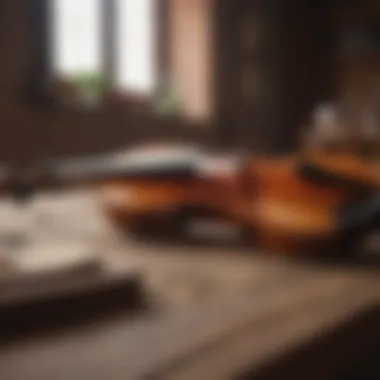Cremonese Violin Makers: A Legacy of Craftsmanship


Intro
The legacy of Cremonese violin makers is a profound part of the narrative of music. The town of Cremona, Italy, is renowned for producing some of the finest string instruments in history. These instruments exemplify not just exceptional craftsmanship but also a significant innovation in the field. The skills of makers like Antonio Stradivari and Guarneri del Gesù set high standards in design and acoustics, influencing generations of luthiers and musicians alike. This article will explore their techniques, the cultural environment of Cremona, and the ongoing relevance of their creations in contemporary music.
Research Highlights
Overview of Key Findings
Cremonese violin makers excelled in various aspects of instrument creation, from the selection of wood to the meticulous attention to detail in construction. Research indicates that the unique acoustic properties of these violins stem from a combination of materials and specific crafting methods. The cultural and economic conditions of the 17th and 18th centuries significantly contributed to the flourishing of violin-making practices in Cremona. These findings underscore the importance of incorporating both historical context and technological advancements in our understanding of these instruments.
Significance of the Research
Understanding the legacy of Cremonese violin makers is essential for several reasons. It reveals not only the technical prowess of these artisans but also their influence on modern musical composition and performance. Moreover, it highlights the interplay between culture and craftsmanship. This research provides valuable insights for students, educators, and professionals interested in the convergence of art, music, and history.
"Cremonese violins are not just instruments; they are a testament to a unique integration of artistry and engineering that continues to inspire awe across the world of music."
Cultural Context
The upbringing of Cremon's violin-making heritage occurred during a time of significant cultural development in Europe. The town was not only a hub for musicians but also a center for artistic exchange. Makers adapted their designs through the influence of evolving musical styles. The rich history of this community is reflected in every handcrafted instrument that bears the Cremona name.
Techniques Employed by Cremonese Makers
Cremonese luthiers employed various techniques that set their work apart:
- Wood Selection: The use of superior quality woods, such as spruce for tops and maple for backs, contributes to the sound quality and durability of the instruments.
- Arching and Thickness: The arching of the plates and their thickness are critical factors that affect sound production and resonance.
- Varnishing: The application of varnish not only enhanced aesthetics but also played a role in the acoustic properties, preserving the wood’s texture and sound.
These methods involved a delicate balance of science and art, essential for crafting violins that resonate with a voice of their own.
Contemporary Relevance
Today, the legacy of Cremonese violin makers carries on in various ways. Modern luthiers often study and replicate their techniques, striving to achieve the same level of excellence. Instruments crafted following these traditional methods still command great respect and high values in the market. Musicians are drawn to Cremonese violins for their unparalleled sound quality, finding inspiration in their rich history.
Foreword to Cremonese Violin Making
Cremonese violin making represents one of the most prestigious traditions in the world of music and craftsmanship. This section serves as a foundation to explore the intricate history behind this art form and its impact on the global music scene. Understanding the origins and significance of Cremonese violins offers insights into the innovative techniques that revolutionized string instrument craftsmanship.
In this article, we will illuminate several aspects of Cremonese violin making, starting from its historical significance to the cultural context of the region. This not only enriches our comprehension of the instruments themselves but also highlights the profound relationship between the makers and the music they enabled.
Significance of Cremona in Violin History
Cremona is often hailed as the epicenter of violin making. The city’s legacy is intertwined with great luthiers who, through their mastery, have shaped the standards of string instruments worldwide. In the 16th and 17th centuries, this region produced exceptional violins, recognized for their unparalleled quality and beauty.
Moreover, the craftsmanship of Cremonese makers established a benchmark that modern luthiers strive to achieve. Instruments made in this city are not just tools for musicians; they are historical artifacts that represent centuries of innovation and tradition. The significance of Cremona goes beyond geography; it reflects a deep cultural and artistic heritage that continues to influence violin making practices today.
Cultural Background of the Region
The cultural backdrop of Cremona is pivotal in understanding the evolution of its violin making. Nestled in northern Italy, the town has been a melting pot of artistic expression, supported by a flourishing community of musicians and craftsmen. The Renaissance played a crucial role in this cultural development, fostering an environment where art and science coalesced.
During this period, there was an increased appreciation for music and the arts. The demand for quality instruments surged as musicians sought out unique sounds that could enhance their performances. This led to a competition among luthiers, encouraging innovation in design and technique. The cultural fabric of Cremona, steeped in rich traditions and a commitment to excellence, underpins why violins from this region are so revered.
In summary, the exploration of Cremonese violin making in this article unfolds a narrative rich with historical significance and cultural context. This sets the stage for a detailed examination of the craftsmanship, artists, and innovations that define this celebrated legacy.


Historical Overview of Cremonese Violin Makers
The historical overview of Cremonese violin makers holds significant weight in understanding the evolution of stringed instruments. This region, particularly known for its unparalleled craftsmanship, gave rise to numerous extraordinary luthiers. Their techniques and innovations not only shaped the violins of their time but also laid the groundwork for contemporary practices. The legacy of these makers is imprinted in the fabric of music history. Examining their contributions offers insights into not just artistry, but also the cultural exchanges and societal influences that directed their work.
The Golden Age of Violin Making
The Golden Age of violin making is often situated between the late 16th century and the early 18th century. This era can be characterized by remarkable advancements in both technique and instrument design. Italian luthiers developed refined methods for crafting violins that offered unparalleled sound quality. Various materials, particularly tonewoods like spruce and maple, were meticulously chosen to enhance resonance and tonal richness. Cremona, with its unique environment and skilled artisans, became the nucleus of this transformative period.
During this time, the craftsmanship did not just focus on acoustics. Aesthetic appeal started to play a larger role in violin design. Instruments from this period exhibit elegant curves and intricate scrolls, pleasing to both the ear and the eye.
Life and Work of Antonio Stradivari
Among the many violin makers, Antonio Stradivari stands out as a titan in the field. Born in 1644, Stradivari's life was dedicated to perfecting the art of violin making. Stradivari transformed the design of the instrument, incorporating elements that enhanced both sound and playability. His violins are markedly known for their bright, powerful sound, making them sought after even today. He experimented with dimensions, arching, and varnishing techniques, producing instruments that are considered masterpieces.
Stradivari was not solitary in his work. He often collaborated with apprentices and fellow craftsmen, sharing knowledge and refining techniques. Today, the instruments crafted by Stradivari are regarded as the epitome of violin making, with some even fetching millions at auction.
The Contribution of Andrea Amati
Andrea Amati is another pivotal figure in the history of Cremonese violin making. Often credited as the originator of the modern violin, Amati set standards that were followed by future generations. His instruments exhibited a harmonious blend of beauty and sound. The craftsmanship of Amati conveyed the transition from earlier string instruments to what we now recognize as the modern violin.
Notably, Amati’s contributions extend beyond his instruments. He established a school of lutherie that influenced many other makers. His family continued his legacy, ensuring that the principles he set forth endured over time. Many of Amati's violins remain in circulation today, showcasing enduring artistry in both craft and design.
Legacy of Guarneri Family
The Guarneri family plays a vital role in the historical narrative of Cremonese violin making. This family, particularly known for the work of Giuseppe Guarneri del Gesù, contributed significantly to the development of the violin. Known for their robust sound and bold designs, Guarneri violins have characteristics that set them apart from their Stradivarian counterparts.
Their instruments are often recognized for their unique tonal qualities. Many musicians regard Guarneri violins as having a distinct emotional depth. The techniques employed by the Guarneri family mirrored the evolving landscape of music at the time, where a more expressive playstyle was becoming prominent.
Overall, the Cremonese tradition of violin making, embodied by Amati, Stradivari, and the Guarneri family, has left an indelible mark on string instrument craftsmanship. Their innovations and artistic achievements continue to inspire luthiers and musicians alike.
Techniques and Materials in Violin Making
The craft of making violins is steeped in meticulous techniques and a deep understanding of materials. This section explores how the choices of tonewoods, construction methods, and varnishing affect the instrument’s overall quality and sound. The significance here cannot be overstated. Understanding these elements is essential for appreciating why Cremonese violins hold such prestige in the musical world.
Selection of Tonewoods
The selection of tonewoods is critical in violin making. Different types of wood each lend their unique characteristics to the instrument. Spruce is often chosen for the top because of its optimal sound projection and tonal properties. Birch and maple, on the other hand, are preferred for the back, sides, and neck, as they provide durability and enhance the brightness of the tone.
Several factors influence the choice of tonewoods:
- Grain Structure: A finer grain can lead to a more uniform sound.
- Moisture Content: The wood must be dried adequately to ensure prevent warping and cracking.
- Density: The density of the wood affects the instrument’s resonance and volume.
Notably, these materials are sourced from specific regions. For example, northern Italy is known for top-quality spruce, while Eastern European maple is often favored for its tonal qualities. The careful selection of these woods contributes significantly to the sublime acoustics of Cremonese violins.
Construction Techniques Used by Cremonese Makers
Cremonese violin makers employ a myriad of construction techniques that have been refined over centuries. One prominent technique is the use of hand tools, including chisels and knives, allowing for precision that machine-made instruments often lack.
Another important technique is the graduation of the wood. This process involves thinning the wood to precise measurements, creating varied thicknesses that affect tonal quality. A well-graduated instrument is more responsive, allowing musicians to express subtleties in their playing.
The use of corner blocks is common among Cremonese makers. These blocks strengthen the structure of the violin while allowing for intricate designs. The arch of the violin, shaped by expert techniques, also influences both aesthetics and sound. These intricate archings ensure the instrument produces a vibrant tone while remaining visually pleasing.


Varnishing and Its Impact on Sound Quality
Varnishing is more than just a protective coating; it plays a crucial role in determining the sound quality of a violin. Cremonese makers typically use oil-based varnishes, which permit the wood to vibrate freely.
A well-applied varnish provides several benefits:
- Protection: It shields the wood from wear and environmental damage.
- Aesthetic Enhancement: Varnishes can enhance the visual appeal, adding depth to wood grain.
- Acoustic Properties: The varnish can promote reverberation and improve tonal clarity.
"The balance between artistry and acoustics is crucial in the varnishing process."
This delicate application process requires years of practice. Each layer applied can alter the sound characteristics, making it a pivotal aspect of violin making. The specific recipes of varnishes often remain secret among luthiers, preserving their unique techniques and sound profiles.
Understanding these elements allows for a greater appreciation of Cremonese violins, emphasizing the blend of artistry, science, and tradition intrinsic to their creation.
The Aesthetic and Acoustic Qualities of Cremonese Violins
Cremonese violins are renowned not just for their craftsmanship but also for their aesthetic appeal and acoustic excellence. These qualities make them highly sought after by both performers and collectors. In examining these aspects, one finds that the design principles and sound characteristics unique to Cremonese instruments contribute heavily to their legendary status in the world of music.
Design Principles of Cremonese Instruments
The design principles of Cremonese violins are crucial to understanding their resurgence in popularity. These instruments often exhibit striking visual elements that make them both artistic and functional. The outlines of these violins are elegant and proportioned, promoting a sense of harmony. Additionally, the arching of the top and back contributes to the overall aesthetics and sound production.
Several features characterize the design of Cremonese violins:
- F-Holes: The placement and size of the f-holes are meticulously crafted, influencing both the visual aspects and the acoustic projection of the instrument.
- Scroll and Neck: The scroll often showcases intricate carving, while the neck maintains a balanced structure that facilitates playability.
- Wood Selection: Usually made from high-quality woods like spruce for the top and maple for the back and sides, these materials are not only selected for their appearance but also for their vibrational properties.
These design elements collectively enhance the beauty of the instrument while ensuring optimal sound quality.
Sound Characteristics of Cremonese Violins
The acoustic properties of Cremonese violins represent their most distinguished attribute. They are known for producing a sound that is both rich and complex. This can be attributed to various factors inherent in the construction methods employed by skilled luthiers.
Key features of the sound characteristics include:
- Projection: Cremonese violins are celebrated for their ability to project sound in a way that fills concert halls. The precise curvature and craftsmanship amplify the sound.
- Timbre: The tonal quality, or timbre, is distinctive. Each violin possesses a unique voice, often described as warm and dark, allowing for expressive playing.
- Sustain: The instruments have remarkable sustain, permitting notes to resonate longer. This quality supports the subtleties of musical expression.
"To play a Cremonese violin is to engage in a dialogue between the musician and the instrument, a conversation fueled by the marriage of aesthetics and acoustics."
Contemporary Cremonese Violin Makers
Cremonese violin making has not ceased to evolve. In the modern world, contemporary Cremonese violin makers continue to maintain the rich traditions established by their predecessors while also embracing innovation. Their work is crucial for several reasons, particularly in keeping the legacy alive and adapting techniques to meet current demands in music and performance. Understanding their contributions provides insights into how classical methods can harmoniously coexist with modern advancements.
Influence of Traditional Techniques on Modern Makers
Many contemporary luthiers in Cremona draw deeply from the well of traditional craftsmanship. They use age-old methods of construction and material selection, ensuring that the essence of Cremonese violin making remains intact. Elements such as:
- Tonewood Selection: Luthiers choose specific types of wood, like spruce for the top and maple for the back, just as their predecessors did. The acoustic properties of these woods are well understood and are critical for achieving the desired sound quality.
- Arching Shapes: The curvature of the violin's body affects sound projection. Modern makers continue to study archetypes set by Stradivari and Guarneri, adapting them carefully while honoring tradition.
- Varnishing Techniques: The finishing layer applied to violins impacts both aesthetics and acoustics. Many current makers study historical varnish recipes, finding ways to replicate their effects while possibly enhancing durability and sound.
By maintaining these traditional practices, contemporary makers preserve the character of Cremonese violins, ensuring that new instruments still carry historical significance.
Profiles of Notable Current Luthiers


Current Cremonese luthiers are a diverse group with varying backgrounds and specialties. Each brings unique perspective and skill to the craft. Here are a few key figures in this community:
- Giovanni Battista Morassi: Renowned for his meticulous attention to detail and dedication to authenticity, Morassi's violins have gained recognition for their clear, resonant sound.
- Pietro de Masi: An emerging luthier committed to blending traditional methods with modern techniques, de Masi has created instruments that appeal to both classical and contemporary musicians.
- Lorenzo Frignani: Known for his innovative approaches to varnishing, Frignani has experimented with natural resins to produce unique finishes that resonate well in performance settings.
The rich legacy of Cremonese violin making continues through the commitment of these artisans, who not only respect tradition but also drive the craft forward.
In sum, contemporary Cremonese violin makers play a vital role in ensuring the ongoing relevance of this esteemed craft. Their work bridges the historical significance of Cremona with today's music, integrating old wisdom with new practices.
The Market for Cremonese Violins
The market for Cremonese violins is a fascinating intersection of art, craft, and commerce. The valuation of these instruments speaks volumes about their historical significance and the craftsmanship behind each piece. It is crucial to understand that owning a Cremonese violin is not merely about possessing a decorative object; it is about owning a piece of musical heritage. The value associated with these instruments often reflects their age, condition, and provenance.
Valuation of Antique Violins
Valuation of antique violins, especially those crafted by notable luthiers like Antonio Stradivari and Andrea Amati, involves a meticulous process. Experts consider several factors:
- Condition: The wear and tear on the instrument greatly influences its overall value. Instruments that have been well preserved or expertly restored tend to fetch higher prices.
- Provenance: Documentation detailing the history of ownership adds to an instrument's value. Provenance establishes authenticity and can generate greater buyer interest.
- Craftsmanship: The expertise that goes into creating a Cremonese violin contributes to its desirability. Instruments embodying the traditional crafting methods are often more valuable than modern reproductions.
- Market Demand: The changing trends among collectors and musicians play a significant role in pricing. Instruments from renowned makers consistently attract high bids at auction.
The most expensive Cremonese violins often reach millions of dollars at auctions, demonstrating their status as both musical tools and investment assets.
Impact of Reputation on Pricing
The impact of reputation on pricing cannot be overstated. The lineage and name associated with a violin considerably sway market value. Renowned names like Stradivari and Guarneri come with a legacy that enhances prices dramatically. Factors that affect reputation include:
- Historical Significance: Violins associated with historically significant composers or performers command higher prices.
- Rarity: Limited production runs and unique features can elevate an instrument's status.
- Cultural Impact: Instruments that have been used in notable performances within prestigious environments, such as concerts or orchestras, possess a cultural significance that translates into market value.
"The immense reputation of Cremonese makers not only affects individual instrument valuations but shapes the entire violin market."
This complex interplay of valuation and reputation forms a crucial component of the Cremonese violin market. As interest in these instruments continues to grow, the legacy of these craftsmen endures in both the musical world and in the markets that value their work.
End: The Enduring Legacy of Cremonese Violin Makers
The craft of violin making in Cremona represents not just a local tradition, but a global influence that shapes the artistry of string instruments worldwide. The legacy left by notable violin makers from the region, particularly during the Golden Age, continues to reverberate through both music and craftsmanship. Their techniques and innovative methods set standards that modern makers strive to achieve.
Cremonese Influence on Global Practices
Cremonese violin makers such as Antonio Stradivari and Andrea Amati cultivated a framework that influenced luthiers across the globe. Their emphasis on precision, quality craftsmanship, and a deep understanding of acoustics established a bar that modern craftsmen still aspire to meet. Today, many contemporary makers study their designs, often replicating or using similar materials to capture the favorable sound qualities associated with Cremonese violins.
- Training and Techniques
- Cultural Exchange
- Luthiers around the world have adopted Cremonese principles in their own practices.
- Workshops and courses dedicated to Stradivari methods are increasingly common.
- International violin-making competitions frequently highlight techniques founded in Cremona.
- Additionally, collaborations between modern luthiers and musicians further the reach of Cremonese methods.
The fusion of traditional techniques with contemporary innovations allows for a rich evolution of violin making. The comprehensive understanding of sound quality and aesthetic details introduced by Cremonese craftsmen remains pivotal in developing instruments that resonate with today’s musicians.
Future of Violin Making in Cremona
The landscape of violin making in Cremona continues to evolve, with new luthiers emerging to uphold the revered traditions while exploring modern advancements.
- Adopting New Technology
- Sustainability in Materials
- Luthiers are increasingly integrating technology into their craft. For instance, computer-aided design software is being used for precise cutting and shaping, enhancing accuracy and efficiency.
- Acoustic analysis tools help makers understand how various adjustments impact sound, allowing for a more scientific approach to craftsmanship.
- There is a growing awareness of the need for sustainable sourcing of tonewoods.
- Some contemporary makers are seeking alternatives or certified woods that do not compromise on quality while respecting environmental considerations.
The future of Cremonese violin making lies in balancing the revered traditions with innovative practices. This approach not only preserves the rich history but also propels the craft into the next generation, ensuring that the legacy of Cremonese violin makers continues to thrive and inspire.







